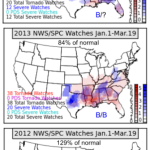We’re doing this cool new segment online at KAMR and I wanted to share it across here. Thanks to Climate Central for the help with this!
Using the database of information offered by the National Weather Service (NWS) in Amarillo, Texas, the number of tornado reports and tornado days was established. From there, the number of “Spring” tornadoes was established removing all tornadoes before February 1 and after July 1. The previous fall and winter precipitation was also obtained from the NWS office in Amarillo. The… Read more →
There was a correlation between the weighted totals of the standard deviations from the mean of the anomalies of GoA SST, GoM SST, Previous Precipitation, ENSO SST when compared against the total number of tornadoes and the number of tornado days for that year for the data from 1996 to 2014. Sixty-three percent of the time when the weighted total… Read more →
There is a lot about forecasting severe weather season across the Texas and Oklahoma panhandle that is controlled regionally and even locally. This statistical analysis does not take that into account. There are too many variables that are measurable, and some that may not be, that go into the equation of a severe weather season. This study was an attempt… Read more →
We’re doing this cool new segment online at KAMR and I wanted to share it across here. Thanks to Climate Central for the help with this!

In Texas, April is the start of a pretty active spring. According to the National Climate Data Center, Texas will see – on average – 28 tornadoes in April. Meanwhile, in the southeast, a “hotbed” for early-spring tornado activity in recent years, most states only average between five and eight tornadoes. Looking back at the past three months, there has… Read more →